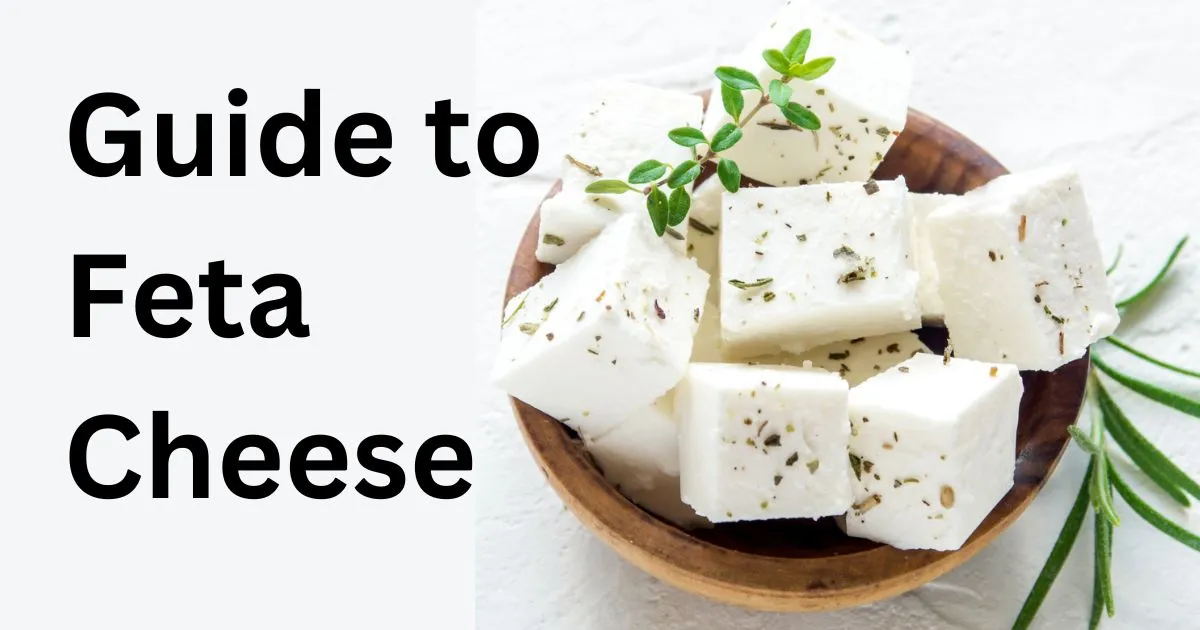Feta cheese is a Greek brined cheese traditionally made from sheep’s milk or a blend of sheep and goat’s milk. It has a salty and tangy flavour profile often with a creamy yet crumbly texture.
The name “feta” is derived from the Greek word “fetta,” which means slice, reflecting how this type of cheese is traditionally formed into blocks and then sliced for a service.
Top 12 Facts About Feta Cheese:
- Source of Milk: Sheep milk (sometimes blended with goat milk)
- Texture: Crumbly and creamy
- Colour: White
- Flavour: Tangy, salty, and slightly sharp
- Fat Content: 40-60%
- Aging Time: Aged for 3-6 months
- Pasteurized: Usually pasteurized
- Country of Origin: Greece
- Town: Produced in various Greek regions
- Named After: The Greek word “feta,” meaning “slice”
- Certification: Protected Designation of Origin (PDO) in Greece
- Uses: Ideal for salads, Mediterranean dishes, and as a topping
Also read: Homemade Ricotta Cheese Recipe
In this guide we will look into Origin and history, how feta is made, uses of different dishes. types of feta cheese.
Origin and History
In Greece, the earliest documented reference to cheese production dates back to the 8th century BC and the technology used to make cheese from sheep-goat milk is similar to the technology used by Greek shepherds today to produce feta cheese.
It has deep roots in Greek culinary traditions. Feta was originally made as a way to preserve surplus milk during warmer months. Over time, its popularity spread across the Mediterranean and beyond, becoming a staple in various cuisines.
The first unambiguous documentation of preserving cheese in brine appears in Cato the Elder’s De Agri Cultura (2nd century BCE) though the practice was surely much older.
How Feta cheese is made
Feta cheese is primarily made from sheep’s milk or a combination of sheep and goat’s milk. Here’s a simplified overview of the production process:
- Milk Collection: Fresh milk, usually from sheep or a mix with goat’s milk (up to 30%), is collected from local farms.
- Pasteurization: The collected milk is heated to kill harmful bacteria while preserving its beneficial components. When the pasteurized milk has cooled to approximately 35 °C (95 °F), rennet is added and the casein is left to coagulate.
- Curd Formation: Rennet is added to the milk to coagulate it into curds. The curds are cut into small pieces to release whey.
- Draining and Salting: The curds are drained and placed in moulds to form blocks. They are salted generously to enhance flavor and preserve the cheese.
- Brining: The cheese blocks are submerged in a brine solution for several days to weeks. This process adds saltiness and helps develop the characteristic texture and taste of feta.
- Ageing: Feta cheese is aged in the brine, allowing its flavors to mature. It’s then packaged and ready for distribution.
ALSO READ: Camembert Cheese: A Comprehensive Guide
For more in-depth information on [topic], you can explore Wikipedia’s detailed entry covering its history, types, uses, and other aspects.
Types of feta cheese
Greek Feta:
- PDO Designation: Authentic Greek feta cheese is protected by the European Union’s PDO (Protected Designation of Origin), ensuring it’s made according to traditional methods in specific regions of Greece using sheep’s milk or a blend of sheep’s and goat’s milk.
- Characteristics: Greek feta is typically creamy and tangy with a slightly salty flavor. It has a crumbly texture and is often stored in brine to maintain its freshness.
2. Bulgarian Feta:
- Ingredients: Bulgarian feta cheese is traditionally made from sheep’s milk or a mixture of sheep’s and goat’s milk.
- Characteristics: It tends to be creamier and milder in flavour compared to Greek feta. Bulgarian feta is less salty and has a smoother texture.
3. French Feta:
- Ingredients: French feta cheese is made from sheep’s milk, cow’s milk, or a combination of both.
- Characteristics: French feta tends to be milder and less tangy than Greek feta. It often has a softer texture and may not be as crumbly.
4. Danish Feta:
- Ingredients: Danish feta cheese is typically made from cow’s milk or a combination of cow’s and goat’s milk.
- Characteristics: Danish feta is usually milder and creamier compared to traditional Greek feta. It has a smoother texture and may be less tangy.
5. Domestic or Local Varieties:
In many countries outside of Greece, local dairies produce their own versions of feta cheese. These varieties can vary widely in flavor, texture, and saltiness depending on local traditions and the ingredients used.
6. Vegetarian and Vegan Varieties:
Ingredients: Some modern variations of feta cheese are made without animal rennet, making them suitable for vegetarians and vegans. These may be made from plant-based ingredients such as tofu or nuts, and they aim to mimic the taste and texture of traditional feta.
7. Aged or Barrel-Aged Feta:
Production: Aged feta cheese is left to mature for a longer period, often several months or even up to a year. Barrel-aged feta is stored in wooden barrels during ageing, which can impart additional flavours and complexities to the cheese.
ALSO READ: The Ultimate Guide to Bel Paese Cheese
Nutritional Benefits of Feta Cheese
Macronutrient Profile Feta cheese is rich in protein and calcium, essential for bone health and muscle function. It also contains healthy fats that contribute to satiety and nutrient absorption.
Vitamins and Minerals High in vitamins B6 and B12, feta cheese supports metabolism and neurological function. It’s also a good source of phosphorus, which is crucial for maintaining strong bones and teeth.
Uses of Feta cheese
Feta cheese, with its unique flavour and crumbly texture, is incredibly versatile in the kitchen. Here are some popular uses of feta cheese that showcase its culinary appeal:
1. Salads:
Feta cheese is a classic addition to salads, particularly Greek salads. Its tangy flavor and creamy texture complement fresh vegetables like tomatoes, cucumbers, and bell peppers. Crumble feta cheese over mixed greens or use it in combination with olives and red onions for a Mediterranean-inspired salad.
2. Appetizers:
Feta cheese can be used in various appetizers to add a burst of flavor. It’s often stuffed into cherry tomatoes or roasted peppers, creating savory bites that are perfect for parties or gatherings. Feta cheese can also be blended into dips such as tzatziki or spinach-artichoke dip, adding richness and tanginess.
3. Pastas and Pizzas:
In pasta dishes, crumbled feta cheese can be sprinkled over hot pasta along with olive oil and herbs for a quick and flavorful sauce. It pairs well with pasta salads too, enhancing the overall taste with its salty tang. Similarly, feta cheese is a popular topping for pizzas, adding a distinct Mediterranean twist to traditional toppings.
4. Baked Goods:
Feta cheese can be incorporated into savoury baked goods like muffins, scones, or bread rolls, adding a cheesy and tangy flavour to the dough. It can also be used as a filling for pastries such as spanakopita (spinach pie), where it melts slightly and blends with spinach for a delicious filling.
5. Sandwiches and Wraps:
Add slices or crumbles of feta cheese to sandwiches and wraps for an extra layer of flavour and creaminess. It pairs particularly well with grilled vegetables, roasted chicken or turkey, and fresh greens. Feta cheese can elevate the taste of simple sandwiches and make them more satisfying.
6. Grilled or Roasted Vegetables:
Sprinkle crumbled feta cheese over grilled or roasted vegetables such as zucchini, eggplant, or asparagus. The cheese melts slightly over the warm vegetables, adding a creamy texture and enhancing their natural flavours.
7. Burgers and Meat Dishes:
Use feta cheese as a topping for burgers along with fresh tomatoes, lettuce, and red onions. It can also be stuffed into chicken breasts or lamb chops before grilling or baking, infusing the meat with its savoury flavour.
8. Stuffed Peppers or Mushrooms:
Stuff bell peppers or mushrooms with a mixture of cooked quinoa or rice, vegetables, herbs, and crumbled feta cheese. Bake until the peppers are tender and the cheese is melted, creating a delicious and satisfying vegetarian dish.
ALSO READ: The Ultimate Guide to Danish Blue Cheese
Learn about the varieties and culinary applications of feta cheese, as well as its cultural importance and protected designation status, at Wikipedia and Cheese.com.
FAQ
What is feta cheese?
Feta cheese is a tangy, crumbly cheese originating from Greece, traditionally made from sheep’s milk or a mixture of sheep and goat’s milk. It is known for its unique flavor and creamy texture.
What are the different types of feta cheese?
Feta cheese can vary based on the type of milk used and its ageing process. Common varieties include traditional Greek feta, Bulgarian feta, and French feta, each with distinct flavours and textures.
How is feta cheese used in cooking?
Feta cheese is incredibly versatile and can be crumbled over salads, used in pastries like spanakopita, blended into dips, or incorporated into pasta and grain dishes for added flavour.
What are the nutritional benefits of feta cheese?
Feta cheese is a good source of protein and calcium, and it is lower in calories and fat compared to many other cheeses. Its tangy flavour means a little goes a long way, making it a flavorful addition to dishes.
More on Cheese
- Exploring Parmesan or Parmigiano-Reggiano cheese
- Mozzarella cheese | Origins, Production, uses
- Homemade Ricotta Cheese Recipe
- Discovering The Cottage Cheese
- The Ultimate Guide to Danish Blue Cheese
- The Ultimate Guide to Bel Paese Cheese
- Cream Cheese Essentials: Everything You Need to Know
- Camembert Cheese: A Comprehensive Guide
- 27 different types of cheese: their origin and uses
- Service of cheese in restaurants
- Cottage Cheese vs Paneer: Differences, Taste, Texture and More
Subscribe and join our community of hospitality professionals & students — get insights, tips, and the latest updates delivered straight to your inbox!







